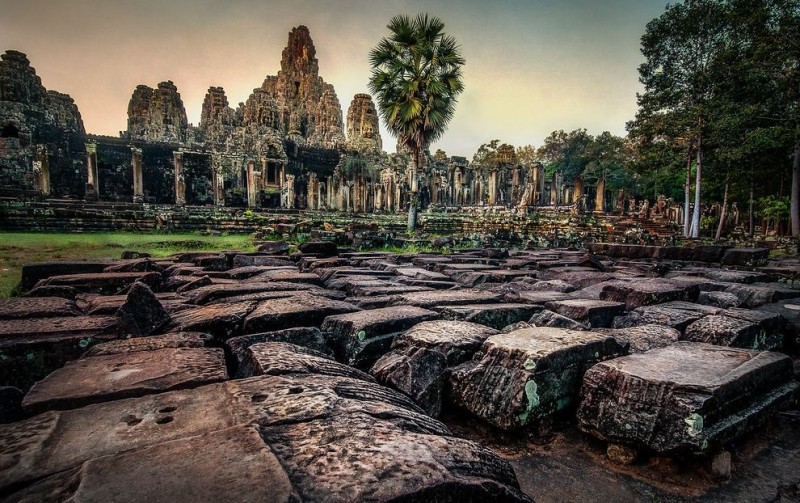
Angkor Wat, the crown jewel of Cambodia, stands as an architectural wonder and a testament to the ingenuity of ancient civilizations. This awe-inspiring temple complex, nestled amid the lush jungles of Siem Reap, has captivated the hearts of countless visitors from around the world. In this article, we delve into the history, symbolism, restoration efforts, and mysteries surrounding the majestic Angkor Wat.
The tale of Angkor Wat dates back to the 12th century when King Suryavarman II envisioned a grand temple dedicated to the Hindu god Vishnu. Spanning over 400 acres, this sprawling complex was initially intended as a state temple and the center of the Khmer Empire. Later, it transformed into a Buddhist temple, reflecting the religious evolution of the Khmer people.
History and Origins of Angkor Wat
Angkor Wat's roots can be traced to the early 9th century when the construction of the Angkor capital began. However, it wasn't until the reign of King Suryavarman II that the iconic temple we see today took shape. The temple's design incorporates elements of both Hindu cosmology and temple mountain architecture.
Architectural Marvels of Angkor Wat
- Grand Entrance and Layout
Angkor Wat's grand entrance is a sight to behold. A moat surrounds the temple, symbolizing the mythical ocean that surrounds the earth. The outer wall represents the mountains at the edge of the world, while the central towers symbolize Mount Meru, the mythical abode of the gods.
- Stunning Bas-Reliefs and Carvings
The walls of Angkor Wat are adorned with intricate bas-reliefs depicting tales from Hindu epics like the Ramayana and the Mahabharata. These carvings offer visitors a glimpse into ancient myths and historical events.
- Towers and Central Sanctuary
The five iconic towers of Angkor Wat rise majestically, representing the peaks of Mount Meru. The central sanctuary houses the revered image of Vishnu, providing a place of worship and pilgrimage for devout believers.
- Enigmatic Faces of Bayon
Located in the nearby Angkor Thom complex, the Bayon temple features mysterious stone faces carved into its towers, creating an enigmatic and mesmerizing atmosphere.
Symbolism and Religious Significance
- Hindu Origins
Originally dedicated to the Hindu god Vishnu, Angkor Wat was designed as a microcosm of the universe, with its layout reflecting Hindu cosmology.
- Transformation to Buddhism
Over time, Angkor Wat underwent a transformation, converting to a Buddhist temple. This religious transition left behind a unique blend of Hindu and Buddhist elements, adding to the site's allure.
Restoration Efforts and Preservation
Angkor Wat faced the wrath of time and nature, experiencing decay and looting. However, extensive restoration efforts by international organizations have preserved its splendor for generations to come.
Visitor Experience and Tips
- Best Time to Visit
Visiting Angkor Wat during the cooler months of November to February is recommended to avoid the sweltering heat.
- Exploring the Temple Complex
Exploring the vast complex requires careful planning, and it's best to cover different sections over multiple days.
- Sunrise and Sunset Views
Experiencing the sunrise and sunset at Angkor Wat is a magical moment that should not be missed. Be prepared to arrive early to secure a good spot.
- Dress Code and Etiquette
Respecting the sacredness of the temple requires modest attire and proper conduct within the premises.
Surrounding Temples and Attractions
While Angkor Wat is the star attraction, the Angkor Archaeological Park is home to several other captivating temples.
- Angkor Thom
The fortified city of Angkor Thom boasts impressive structures like the Terrace of the Elephants and the Bayon.
- Ta Prohm
Known for its ancient trees intertwined with the temple ruins, Ta Prohm offers a surreal and mysterious ambiance.
- Banteay Srei
This smaller but no less mesmerizing temple stands out for its intricate pink sandstone carvings.
- Phnom Bakheng
Climbing this hilltop temple to witness the sunset over Angkor Wat is a popular activity among visitors.
Angkor Wat and Popular Culture
Angkor Wat's timeless allure has captured the attention of filmmakers, writers, and artists, inspiring numerous works of art and becoming a symbol of Cambodia's cultural heritage.
The Mystery of Angkor Wat
Despite centuries of research, some aspects of Angkor Wat's history and purpose remain shrouded in mystery.
- Lost City Theories
Some historians speculate that Angkor Wat might have been part of a vast network of cities interconnected by roads and canals.
- Legends and Myths
Legends of hidden treasures and ancient curses add an air of mystique to the temple's already captivating aura.
Angkor Wat stands as a timeless masterpiece, a testament to the Khmer Empire's architectural genius and spiritual devotion. It continues to be a beacon of Cambodia's cultural heritage, drawing visitors from far and wide to unravel the mysteries of this enigmatic temple complex.
Sawan's Third Monday throngs Devotees to Temples
Secularism and Religion: Striking the Balance for Peaceful Coexistence
The Significance of Om: The Sacred Sound of Universal Harmony